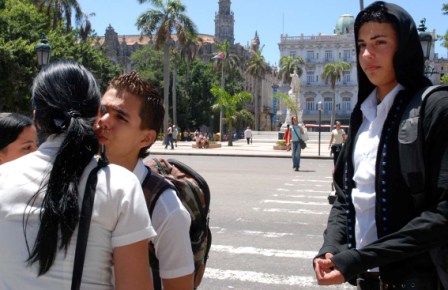Cuba’s Adios to Students in the Fields

HAVANA TIMES, July 28 — If I told you that the FAPI, the BETs and the BUTS’s are now history, readers from around the world would more than likely draw a blank. But these strange abbreviations more than likely take the thoughts of the average Cuban back to their student years.
These stand for the Forces of Pioneer Action, the Brigades of Working Students and the Brigades of Social Work University Students, and they were each part of the formula used to organize the workforce contribution of students at the three educational levels on the island.
At the elementary school level, children would carry out social tasks such as gathering raw materials, cleaning schools or planting trees. It was generally fairly amusing work in which the students were integrated into the community.
With the secondary school students the matter was a little more serious. They had to live in rural areas for one month devoting themselves to agricultural work on state farms and in cooperatives. Their tasks involved everything from harvesting potatoes to weeding tobacco fields.
During the economic crisis of the ‘90s, my children were sent to a BET, where I got to visit them in their camps located dozens of miles from Havana. They didn’t live so poorly; it wasn’t a hotel but they each had a roof, a bed and got three square meals a day.
Those who suffered were the parents. They would spend each week trying to find food to take to their kids on Sundays, as well as chipping in on gas to go in groups by car to see them; others would have to travel by train or even hitchhike.
For many years senior high schools were located in rural areas, where the students were also lodged, so it was relatively easy to organize work in the areas surroundings the schools, combining this labor with class instruction.
The university brigades were mobilized more for campaigns, generally when the school year had ended; however, classes were sometimes interrupted and the college kids shepherded back into the fields if a lack of labor was putting some crop at risk.
The concept on which these mobilizations of more than a million students were based came from the thinking of the island’s national hero, Jose Marti, who recommended creating “an orchard behind each school,” thereby combining work with study in the upbringing of young people.
As a principle I found it interesting, and personally I never participated with my children when they came up with schemes to get out of working in the fields. However, with the passing of time I came to understand how little of that program was worthwhile.

Boys and girls don’t have the necessary experience for agricultural labor and the work often resulted in more damage than benefits. To the low productivity should have been added the expenses associated with transportation, food services and the maintenance of housing.
According to the newspaper Juventude Rebelde, the elimination of these brigades was due mainly to the fact that “time has passed.” However, following such a self-evident assessment, the paper recognized that there had existed an “unfavorable cost-benefit correlation.”
If the brigades spent more than what they contributed, they could only be justified as a method for “the formation of the younger generation.” But what’s certain is that work can only play that role if it’s socially useful.
That’s the reason the work-study combination works so well in the health care environment, where medical students work in hospitals acquiring vast experience while at the same time supporting the national health care system.
The end of the farm work brigades is part of a greater reorganization of the educational system towards a more pragmatic one in which, for example, there will be increases in the number of students per classroom in exchange for providing them with properly trained educators.
In few sectors in Cuba can there be perceived as many changes as in education: they have shut down the senior high schools in the countryside program, they have put limits on the size of the incoming university class, they’ve enlarged the program for mid-level technicians, they’ve created opportunities for the training of skilled workers and the system is orienting all of this training toward the real needs of the economy.
This educational reform has gone by almost unnoticed internationally, despite it offering itself as one of the changes that will do the most to transform national life in the long term. The results will be less dramatic but much more useful for the Cuban economy.
The importance that the government is giving to this process became patently clear in 2009 when the individual appointed as the minister of Higher Education was Miguel Diaz Canel, a member of the Politburo of the Party, the highest authority of power on the island.
—
An authorized translation by Havana Times (from the Spanish original) published by BBC Mundo.






I wonder what the loss will be to the students though, in terms of building a sense of community participation and, in the case of farming, the connection to the environment…something that urban kids in the US completely lack. Hopefully those positive aspects of the program will be picked up by other types of community projects. For example (albeit a poor example) in the US we have things such as Eagle Scouts and Girl Scouts that take kids camping and involve them in tree planting and community service work at soup kitchens etc.